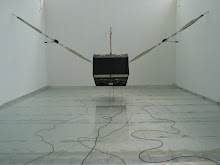The art of trucking, Malian style
To say that Kayes is hot is an understatement: the Rough Guide lists it as Africa’s hottest town. The barometer pushes well over 40 degrees Celsius everyday, and it is not uncommon to see groups of people, especially the truckers, sleeping by the roadside as the sun follows its conveyor-belt arc across the sky. Some lie in groups, others alone, some on the floor; luckier ones rest in customised hammocks attached to the underside of their large articulated vehicles.
Although populated by Bambara-speaking Malians, the name Kayes is pure Senegalese; it means “come here” in Wolof. Legend has it the town got its name from impatient travellers standing on the banks of the river calling out to the ferryman. Despite the urgency its name implies, Kayes has always been a place of pause. Situated on the Senegal River, Kayes is (more or less) the halfway mark between the Malian capital of Bamako and the port of Dakar, in neighbouring Senegal.
If you ignore the whistle-blowing traffic police and slow-paced customs officials, the town offers the attraction of entertainment, porn movies at an outdoor cinema and cheap roadside grub. Mariam Barry’s saga-saga-nan, a meaty stew of cooked entrails served with Thai-style rice, is typical.
I meet Lassine Sanogo, a 38-year-old trucker and fan of footballer Didier Drogba, a short distance from where Barry’s ramshackle eatery stands. He is delivering cotton, he says. So too is 53-year-old Drissa Diarra, whom I meet further down the main road, which is backed-up with parked trucks. Point being: trucks deliver almost everything in the region. While Mali has an airport, also a functioning railway line, as is the case in South Africa, and indeed most other places in the world, trucks do it faster, quicker, now, now, now.
Their ubiquity, both in Mali as elsewhere, hints at an idiosyncratic lifestyle, one that is often approached (rather than understood) by its cosmetic adornments.
In Japan, for instance, truckers there add impossible chrome and metal extensions to their vehicles, also bright flashing lights and visually excessive paint motifs. The net effect is something intriguingly futuristic, never mind the fact that the interior cabins of these Japanese trucks tend, typically, to be filled with fluffy toy dolls. It’s the same in Kayes, just different. One obvious difference is the condition of the trucks. To use a great English expression, they’re shagged, completely.
Still, these trucks, for better or worse, are home. Drissa Diarra knows as much. He has been driving since 1979. Although married with four children, he is rarely with his family. “I see them maybe once a month,” he says. On most nights he sleeps in front of his truck, on a stretcher, covered by a blanket and a mosquito net.
It is perhaps because of this simple reality, of never being home, of always being elsewhere, on the road, that these Senegalese and Malian workingmen, much like their Japanese counterparts, take such great pride in their trucks. Instead of driving around in featureless mobile homes, as tends to be the case in South Africa, their vehicles are richly decorated.
Where some West African trucks are full of stickers bearing the faces of influential Islamic teachers, or vinyl-cut lettering announcing a terse Koranic admonition, other truckers find their spiritual sustenance elsewhere, Bob Marley, for example. Senegal being such a proud football nation, it is not uncommon to see trucks featuring prominent images of lions, the symbol of the national team.
Of the many animal motifs I encountered, a naff bunny painted onto the front of 25-year-old Sekouba Kone’s truck was the most peculiar. “I used to breed rabbits before I became a driver,” explains the demure trucker. That was 1994; he was still a teenager living with his parents in a village outside Bamako.
“I had six rabbits. One day a thief stole all of them.” He says he paid a local sign writer (R61) to paint the bunny. Given that the average monthly income of a trucker is (R770), such decorative adornments are by no means cheap indulgences.
Perhaps a kernel of wisdom, rather than a literal explanation of why drivers indulge in such seemingly unnecessary expenses, is offered by 62-year-old Coulbaly Tahirou. “A good driver does three things,” he asserts. “You look out for your own truck, the one in front, and the one behind.” Ironically, in looking out for their own exhausted trucks, however whimsically, these West African truckers have managed something unexpected. They make others look too, appreciatively, in amazed wonder.







